Italian Jarred Tomatoes Two Ways
Preserving the vibrant flavors of summer is easier than ever when you jar your own tomatoes, whether you decide on tomato puree or jarred pelati. This timeless Italian tradition will capture the peak ripeness and sweetness of fresh tomatoes which can be used for so many delicious Italian dishes.

I remember the hot summer days of jarring tomato passata (conserva) and pelati tomatoes with my sister-in-laws, mother–in-law, father-in-law, husband, brothers-in-law and kids, oh yes everyone was involved in a garage with big huge containers of tomatoes all ready to be bottled. Of course Maria (MIL) was the supervisor. I think the kids mainly hung around just so they could get a taste of any leftover conserva served on fresh bread with a sprinkle of salt and a drizzle of olive oil or as we called it Panzanella!
Tomato puree is one of the most popular homemade Italian traditions, especially in the regions of Southern Italy. Both tomato passata also known as conserva or puree and peeled (pelati) tomatoes are prepared at the end of summer, just when the juicy and tastiest tomatoes are available. They are canned and stored in the pantry to be enjoyed during the cooled fall and winter months.
Recipe ingredients
- Tomatoes
- Fresh basil
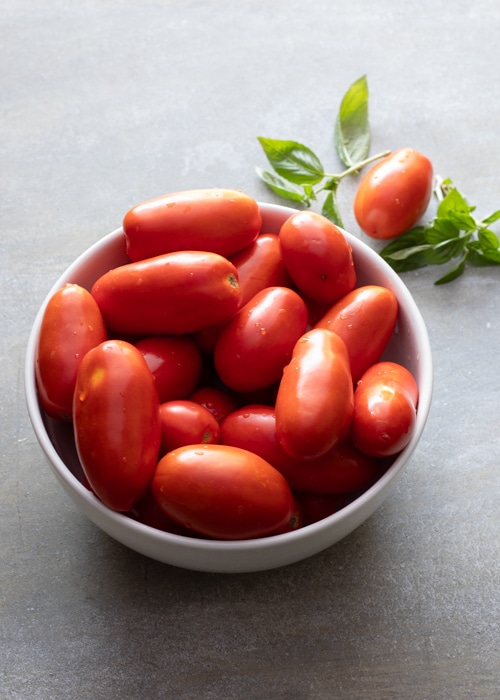
Making jarred tomatoes
Making either is very simple, just follow a few simple steps to obtain a delicious, velvety puree or tasty pelati tomatoes perfect for using in Bolognese sauce, Lasagna, stews, pasta dish or any of your favorite recipes. For the full instructions see the recipe card at the bottom of the post.
Clean the tomatoes well in clean cool water. There is no need to use any chemical cleaner on the tomatoes. Wash the jars and lids in hot soapy water, then rinse well and drain. Place the jars and lids in a large pot of boiling and boil. Then drain the jars upside down on a clean tea towel with the lids to dry and cool. Here you will find other ways to sterilize the jars.
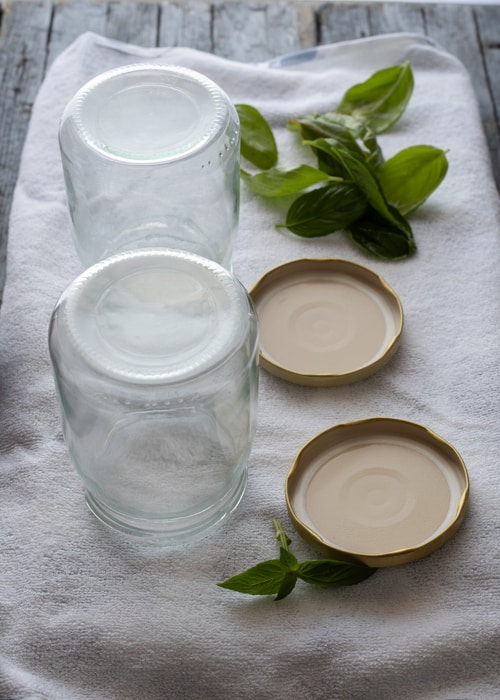
FOR THE PUREE AND OR PELATI TOMATOES
In a large pot of boiling water add the tomatoes and cook. For the puree I cut the tomatoes in half and boiled a bit less. For the pelati I left the tomatoes whole and boiled, you just want to be able to remove the skin easily, not cook them.
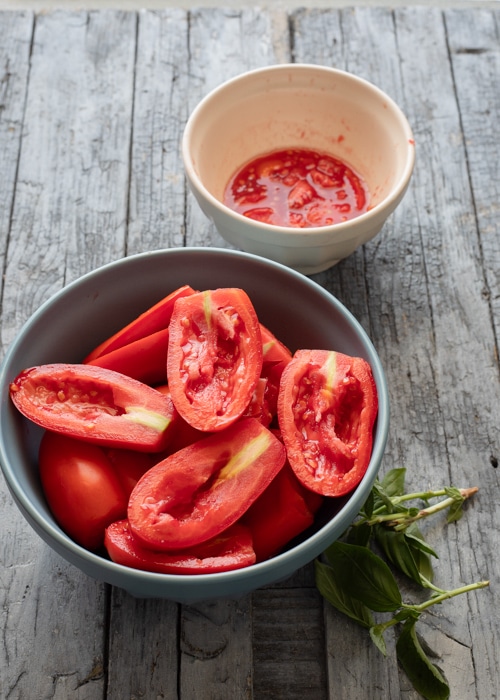
Put the boiled tomatoes through a food mill, the food mill will remove the seeds and skin, place some leaves of fresh basil at the bottom of the jar and pour the puree on top, leaving a small amount of space. Seal the jar well with the tight fitting lid and set aside.

FOR THE PELATI
Remove the tomatoes and let cool enough to handle. Then remove the peel, slice in half, remove the seeds and gently squeeze to remove excess liquid but not all. Place fresh basil leaves at the bottom of the jar and add the tomatoes on top. With a wooden spoon push down on the tomatoes to remove any air bubbles before sealing leaving a small amount of space. Seal the jar well with the tight fitting lid and set aside.

FOR BOILING THE FILLED JARS
Place the jars lid side down in a large pot, big enough so they can be completely covered with water, place towels around the jars so they won’t break while boiling. Cover with water and bring to a boil and boil, turn off the heat and let sit in the water. Remove from the pot and store.
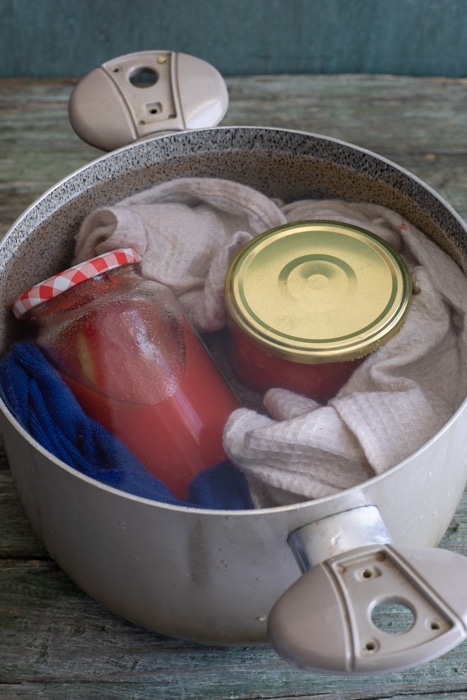
What are the best tomatoes to use?
To make an excellent tomato puree you can use a different types of tomatoes, from round tomatoes to oblong (plum) to San Marzano (which we prefer), my mother-in-law would actually toss in quite a mixture. Whichever you choose make sure they are ripe to the right point, meaning, free of dents, mold and not soft.
Recipe Tip
It is also important to remember that homemade preserves must always be checked before they are consumed. Therefore you should make sure that the flavour, color and smell is the same as when you stored it. If even one of these has changed and is off, do not hesitate to dispose of it.
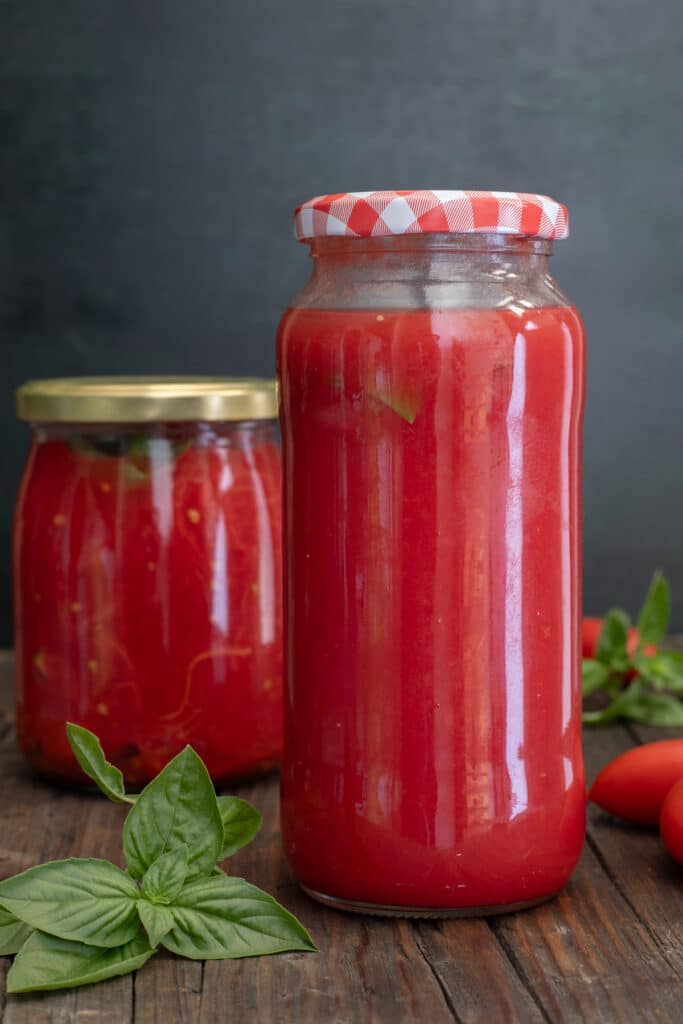
What are the best jars to use?
I recommend purchasing airtight jars that are about 2 -2 1/2 cup (500ml) in size. If the tomatoes were to spoil then you will be discarding lesser amount. And most recipes will call for about this amount.
Why turn the jars upside down when boiling the filled jars?
When the jar is boiled, any air and water vapor inside will expand and escape through the cap. The boiling process creates pressure that pushes the seal upward, allowing air and steam to exit easily. As the jar cools, the remaining gases contract, creating a vacuum that pulls the seal tightly against the jar’s rim, ensuring the lid adheres perfectly. This vacuum preserves the sterility achieved during boiling by preventing air from entering, keeping the contents safe and properly sealed.
tips for making the best jarred tomatoes
- Choice of ingredients – Using fresh, ripe tomatoes is a must. Make sure they are free of bruises, dents and not mushy.
- Hygienic processing – Always use clean tools and containers. Washing your tomatoes thoroughly before starting is also important.
- Sterilization of containers – If you plan to store the puree in glass jars, be sure to sterilize them before filling them with the sauce. This will reduce the risk of contamination.
- Adequate cooling – After cooking, let the puree cool before storing the jars whether in the fridge or pantry.
- Hygiene – When removing the sauce from the container to the jars be sure to do so with clean utensils this will avoid contamination.
More recipes using jarred tomatoes
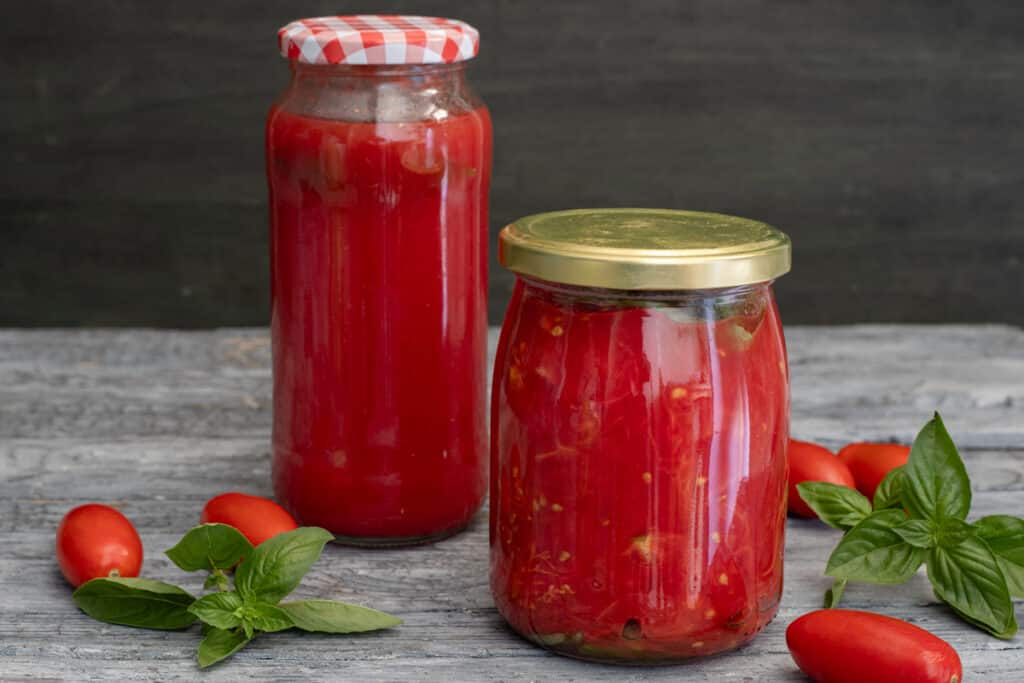
Jarring your own Italian tomatoes is a simple and rewarding way to preserve the rich, authentic flavors of this wonderful fruit. I hope you enjoy it!
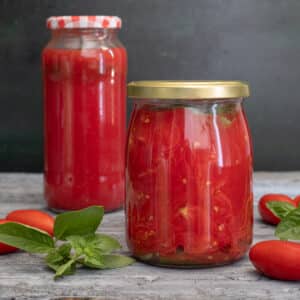
Italian Jarred Tomatoes Two Ways
Ingredients
- 4.4 pounds tomatoes
- 6-8 fresh basil leaves
EXTRAS
- 2 glass tight fitting closed jars (with new lids) (2½ cups / 550-600 ml)
Instructions
- Clean the tomatoes well in clean cool water. There is no need to use any chemical cleaner on the tomatoes.
- Wash the jars in hot soapy water, then rinse well and drain. Place the jars in a large pot of boiling water for 10 minutes.Then drain the jars upside down on a clean tea towel to dry and cool. Here you will find other ways to sterilize the jars.
FOR THE PUREE AND OR PELATI TOMATOES
- In a large pot of boiling water add the tomatoes and cook 1-2 minutes. For the puree I cut the tomatoes in half and boiled for about 1 – 1½ minutes. For the pelati I left the tomatoes whole and boiled for 2 minutes, you just want to be able to remove the skin easily, not cook them.
FOR THE PUREE
- Put the boiled tomatoes through a food mill, the food mill will remove the seeds and skin, place 3-4 leaves of fresh basil at the bottom of the jar and pour the puree on top, leaving about one inch / 2-3 cm of space. Seal the jar well with the tight fitting lid and set aside.
FOR THE PELATI
- Remove the tomatoes and let cool enough to handle. Then remove the peel, slice in half, remove the seeds and gently squeeze to remove excess liquid but not all. Place 3-4 leaves of fresh basil at the bottom of the jar and add the tomatoes on top. With a wooden spoon push down on the tomatoes to remove any air bubbles before sealing leaving about one inch / 2-3 cm of space. Seal the jar well with the tight fitting lid and set aside.
FOR BOILING THE FILLED JARS
- Place the jars lid side down in a large pot, big enough so they can be completely covered with water, place towels around the jars so they won't break while boiling. Cover with water and bring to a boil and boil 34-40 minutes turn off the heat and let sit in the water, i usually go overnight or at least 8 hours. Remove from the pot and store. Enjoy!
Your instructions say place the glass jars lid side down, but your pictures shows them on their side and also I have never heard of placing them lid side down I would have them standing upright is there a special reason for lid side down?
Hi Diana, yes it was a long day and my husband noticed also :), although I did correct it before boiling. When the jar is boiled, any air and water vapor inside will expand and escape through the cap. The boiling process creates pressure that pushes the seal upward, allowing air and steam to exit easily. As the jar cools, the remaining gases contract, creating a vacuum that pulls the seal tightly against the jar’s rim, ensuring the lid adheres perfectly. This vacuum preserves the sterility achieved during boiling by preventing air from entering, keeping the contents safe and properly sealed. Hope that helps. Take care!
Sound like great recipes. I think I’ll freeze mine. Be aware that some newer tomato cultivars are lower acid so newer approved canning methods require either adding lemon juice and boiling 45 minutes or pressure canning. You might be able to check which varieties are like this on the web. Anyway we don’t want anyone getting salmonella.
Hi Nancy, thanks so much, yes I usually freeze mine too, since I don’t make as much as I used to. Take care!
Thank you so much! Wonderful recipes 🙏 😊 🙏
Hi Paola, thanks so much, so glad you enjoy the recipes! Take care.
Buongiorno Rosemary. It is so good to have fresh tomatoes to use in the winter. I thought that you always had to use new lids when canning. That once they were used you could not reuse them because the seal is not the same. I see from your photos that it looks like you are using previously used lids. Please advise. Thanks for your wonderful website.
Hi Pamela, you should use new lids every time, those are new lids I used. Hope that helped. I added it the post. Thanks and you’re welcome, glad you enjoy the website. Take care!